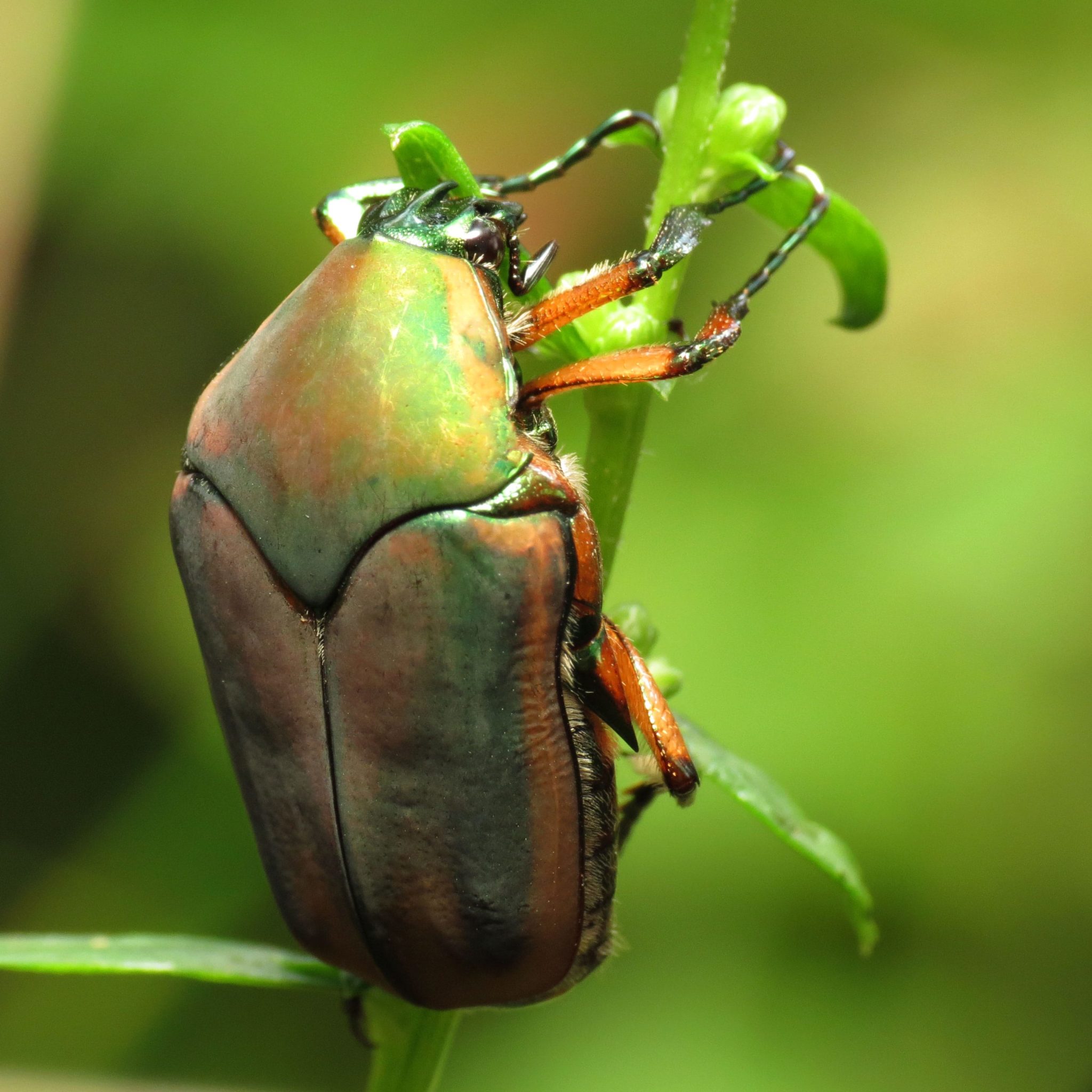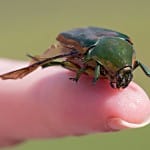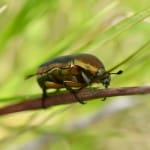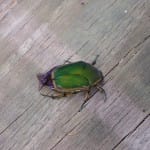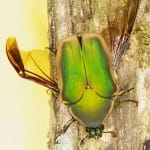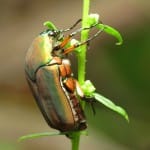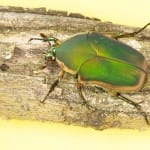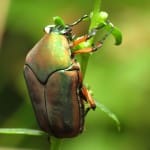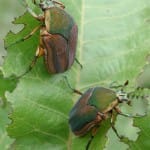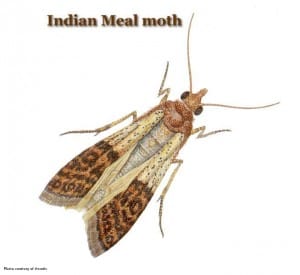Source(s):
- Patricia P. Cobb, Professor Emeritus, Entomology and Plant Pathology, Auburn University.
- Kathy L. Flanders, Extension Entomologist, Associate Professor, Auburn University.
Damage caused by green June beetle grubs, Cotinis nitida L., has been increasing in Georgia landscapes, home lawns and other established grassy areas. Although green June beetle grubs prefer to feed on decaying organic matter, they can chew the tender roots of grass plants. Damage to turf and pasture is primarily mechanical because grub tunneling and movement in the soil uproot grass plants, which then dry out and die.
Description of Green June Beetles
Green June beetle adults are velvet green with orange or rust stripes along the outer margins of the wing covers. Beetles may be 1/2 to nearly 1 inch long. Peak beetle flights begin during late June, thus the common southeastern name, June bug. Fully-grown green June beetle grubs, commonly called grub worms, are also familiar sights. Green June beetle grubs are most abundant in sandy or sandy loam soil rich in organic matter.
Green June beetle grubs are different from most grub species in the southeastern United States in that they come out of the ground at night and move from one place to another. Green June beetle grubs crawl on their backs with their legs in the air. This movement easily distinguishes them from most other grubs in the soil. When disturbed the grubs curl up into a C-shape, typical of the grubs in their family, the Scarab beetles. Grubs of some related beetles, called Euphoria, or bumble flower beetles, also crawl on their backs. They might occasionally be confused with green June beetle grubs; however, bumble flower beetles are not known to cause extensive damage to turfgrass or pastures.
Green June beetles have one generation each year. The grubs overwinter in the soil. They may become active during warm winter days. Fresh mounds of trails of pulverized soil indicate fresh grub activity. Grub activity increases as the spring weather becomes consistently warmer.
Grubs pupate in cells in the soil during late April and May and remain in the pupal stage for 2 or 3 weeks. Newly emerged adults remain in the soil for an additional week or two. In most years, green June beetles leave the soil beginning in late May and continue through early August. Peak flights usually occur from June through July.
Behavior of Green June Beetles
As adults, green June beetles feed on fruits such as apples, peaches, and figs. Usually, they prefer to eat over-ripe or decaying fruit. Occasionally, adult green June beetles feed excessively and cause economic damage to grapes and small fruits.
Female beetles fly over the grass surface early in the morning and settle into the grass just after daybreak. Male beetles fly during mid to late morning. Female beetles produce substances that attract the males to them. After mating, the female green June beetle flies close to the turf or grass surface, selects a site (preferably moist, organic soil), and digs several inches into the soil. The female beetle constructs a walnut-sized ball of soil in which she lays 10 to 30 eggs. Eggs are nearly round, about 1/16 inch in diameter. Each female may lay as many as 75 eggs during a 2-week period. Eggs hatch in about 2 weeks. Newly hatched grubs are about 3/8 inch long. Young grubs begin to tunnel through the soil in search of food (organic matter). They typically come to the surface to feed.
In turf, the grubs usually leave small mounds of soil around the mouth of each tunnel. By August, grubs are large enough for mounds to be seen on short mowed turf and by mid-September on taller grass. In pastures, grubs leave trails of pulverized soil as they tunnel near the surface.
A small amount of green June beetle tunneling can help aerate the soil and be beneficial; however, extensive tunneling can be harmful. Tunneling loosens the soil and creates a spongy layer about 2 inches deep in heavy infestations. Tunneling disrupts the contact between the plant roots and the soil. This interferes with water up-take causing the plants to die.
Grubs are capable of pruning the roots of plants, particularly when the grubs occur in high numbers. In pasture situations, grazing cattle easily pull the plants growing in the loosened soil out of the ground. Weeds quickly colonize the bare patches created where a plant dies or is pulled out. Birds, armadillos, and skunks dig grubs out of turf and pastures, often causing even greater damage in the process.
A large, dark-colored wasp, Scolia dubia, is often seen flying low over grassy areas infested with green June beetle grubs. The insect, sometimes called the blue winged wasp, attacks green June beetle grubs, and is, therefore, beneficial. This wasp is blue-black in color, slightly longer than an inch. The rear half of the abdomen is brown and fuzzy, with two large yellow spots. The female wasp goes down into the soil to find green June beetle grubs. When she finds one, she stings it, causing it to be paralyzed, then lays her eggs. The wasp larvae hatch and consume the green June beetle grub. In Alabama, wasp adults are most prevalent in August and September. Under some circumstances, this insect, and some microbial pathogens, will control a green June beetle infestation.
Management on Turf of Green June Beetles
On turf, green June beetle control is site specific. In some cases, the grubs do such a good job of aerification that control is considered to be undesirable. This is especially true on rapidly growing, well-established bermudagrass that is not closely mowed. However, green June beetle mounds are usually not tolerated on highly visible areas such as highly maintained lawns or golf greens. Sod producers need to guard against this pest because the tunneling weakens the structural strength of the sod.
The following are steps for successful control on turf:
- Be sure you have green June beetles. Green June beetles are not the only animals that make mounds on turf. Mole crickets make mounds during the spring and fall on infested turf, primarily in the southern half of Georgia. Earthworms also make mounds, the particles of which are distinct pellets. To determine which animal is creating mounds in an area, use a mixture of 1 or 2 tablespoons of lemon-scented dish detergent in 1 gallon of water. Pour the solution over 1 or 2 square feet of the infested area. Wait a few minutes, and observe what comes out of the ground.
- You can also verify the presence of green June beetle grubs by digging up with a shovel several samples at least 1 foot deep and 1 foot square. Sift through the soil to find any insects.
- Identifying GJB activity (as opposed to ants, mole crickets, etc.) can be tricky, but look for tunnels about the size of your finger (bigger than a pencil, for large grubs) going straight down from the center of the mound of dirt. The tunnel will be open if it’s where the grub came up, or covered if it’s where it went back down into the ground. Soapy water will not bring the grubs up reliably, but it will get mole crickets and earthworms up. Digging is the most accurate method but also the most trouble.
- Watch for bird feeding in turf areas, especially starlings and robins. Bird activity is a good indicator of turf insect infestations. Also, watch where green June beetle adults fly during the summer.
- Decide whether turf damage is severe enough or unsightly enough to justify treatment.
- Consider control options. The insecticides recommended for grub control in The Georgia Pest Management Handbook will control green June beetle grubs.
- Any of the pyrethroids, and Sevin, are effective for controlling the grubs, at any size, if applied late in the day. Because the grubs come up and wallow around in the materials, they work on even mature grubs very well.
- In most years, the best time for grub control is August through October. Treatments during early spring will probably give a lower percentage of control. Often, a second application is required.
- If soil is dry, irrigate before treatment.
- Make applications late in the day because grubs move to the surface during the evening.
- Treat all infested areas. Otherwise, grubs may later move back into treated areas.
- Keep a history of the site. Mark a landscape map with previously infested areas. This can help in locating new infestations.
- Remove dead grubs if necessary. Following an insecticide application, grubs emerge from the ground the next evening and die on the turf or soil surface. Decaying grubs not only smell bad, but also may result in slick playing surfaces on athletic turf. Usually, you can remove dead grubs from athletic fields or other frequently trafficked areas with a turf sweeper such as the ones used on golf courses.
Resource(s): Insect Pests of Ornamental Plants
Reviewer(s): Will Hudson, Ph.D., Extension Entomologist, The University of Georgia.
Center Publication Number: 214
